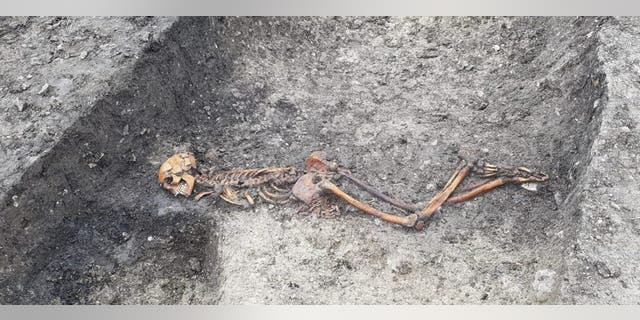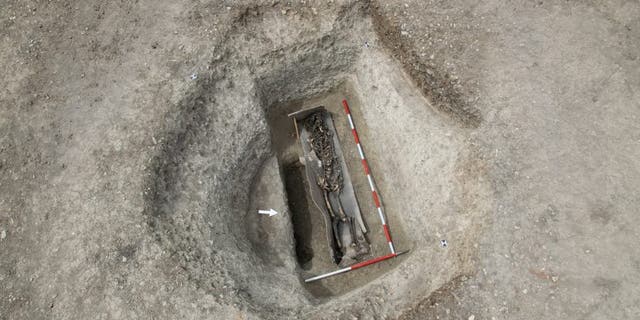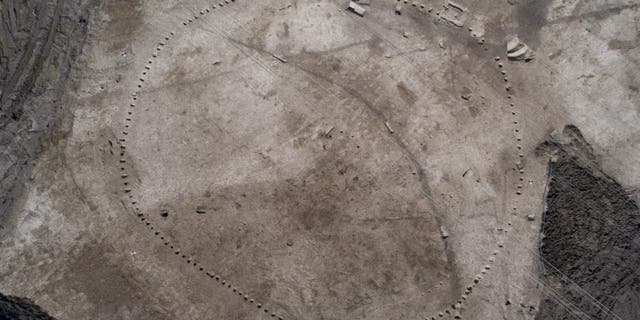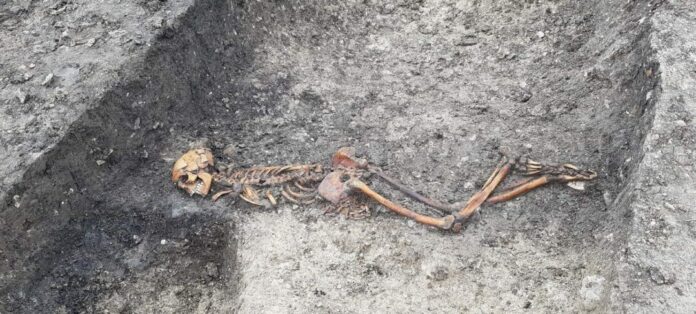While digging to start construction on a high-speed rail project in the U.K., archaeologists uncovered a skeleton that may be a “murder victim” from the Iron Age.
The skeleton, which is laying face down, with its hands bound under its pelvis, was recovered near an area occupied by the British during both the Bronze and Iron ages, Wellwick Farm. The burial style suggests either the adult male, his identity unknown at this time, was murdered or executed.
“The death of the Wellwick Farm man remains a mystery to us but there aren’t many ways you end up in a bottom of a ditch, face down, with your hands bound,” project archaeologist Dr. Rachel Wood said in a statement. “We hope our osteologists will be able to shed more light on this potentially gruesome death.”

Skeleton of adult male at Wellwick Farm, uncovered by HS2 archaeological works. (Credit: HS2)
TOMB OF IRON AGE MYSTERY MAN DISCOVERED IN ITALY. AND THERE’S A CHARIOT INSIDE.
A number of other skeletal remains were found while digging up for the rail project, the largest in Europe, according to The Sun.
A skeleton in a wood coffin lined with lead was also found, with researchers believing the person was one of wealth and high status, given the burial method.

High status burial in a lead-lined coffin, with the outer coffin likely made of wood. (Credit: HS2)
A wide circular timber monument measuring 213 feet in diameter “with features aligned with the Winter Solstice, similar to Stonehenge in Wiltshire,” was also discovered, as was a gold stater coin, from the 1st century B.C.

An aerial view reveals the scale of the circular monument. (Credit: HS2)
“We already knew that Buckinghamshire is rich in archaeology but discovering a site showing human activity spanning 4,000 years came as a bit of a surprise to us,” Dr. Wood added. “The large wooden ceremonial structure, the Roman lead burial and the mystery of the skeleton at Wellwick Farm helps bring alive the fact that people lived, worked and died in this area long before we came along.”
TOMB OF IRON AGE ‘PRINCESS’ ADORNED WITH JEWELRY DISCOVERED
A number of Iron Age finds have been discovered in recent memory. In February 2019, researchers found more than 100 fragmented human skulls buried in an open area of Le Cailar, France — a 2,500-year-old town on the Rhone River.
Researchers gathered evidence in May 2019 that Iron Age Celts drank Mediterranean wine as far back as 2,700 years ago. Separately in May 2019, an Iron Age shield made from bark, the first of its kind found in Europe, was analyzed by researchers.
In July 2019, researchers unearthed the grave of a Celtic female who was buried in approximately 200 B.C. in a tree coffin and adorned with precious jewelry.
In February, 70,000 coins from the Iron Age that were discovered in 2012, set a Guinness World Record for being the largest of its kind discovered in the British Isles.
The Iron Age was preceded by the Stone Age and the Bronze Age and lasted between 1200 B.C. and the 1st century A.D., depending upon the region of the world.






